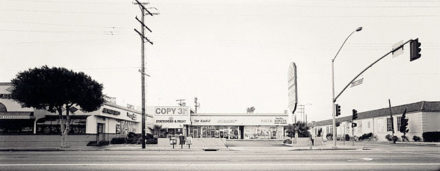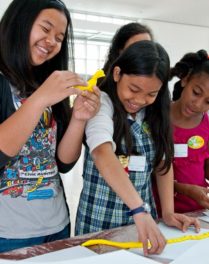
Statue of a Kouros (The Agrigento Youth), Greek, about 480 B.C., Museo Archeologico Regionale, Agrigento, Sicily. Photo © Angelo Pitrone
Centuries ago, a marble sculpture known as the Agrigento Youth took a violent fall, losing his nose and parts of his arms and legs. The cause? Likely an earthquake.
The statue, loaned to us by the Museo Archeologico Regionale in Agrigento as part of our partnership with the Sicilian Ministry of Culture and Sicilian Identity, begins his journey from the Getty Villa back to Sicily at the end of this month. But this time he’ll be protected from tumbles, thanks to a high-tech mechanism concealed in his base.
Inside the unassuming charcoal-grey pedestal is what’s known as a base isolation system, a device developed by conservators and mount makers at the Getty Villa to protect artworks from earthquake damage. It features two frames atop one another that utilize ball bearings within tracks to slide in different directions, buffering objects from the destructive force of shaking and liquefying earth.
See it in action here in a demonstration by Jerry Podany, senior conservator of antiquities. (Look what happens to the terracotta form that’s not on a base isolation system when the simulated quake hits.)
Working with colleagues from the Museo Archeologico Regionale, Getty conservators and mount makers fitted the Agrigento Youth with a base isolation system tailored to its size and weight when it first arrived at the Getty Villa, the same welcome extended to the Gela Krater when it came on loan from the Museo last spring.

The Agrigento Youth being fitted onto its new pedestals by conservators and mount makers at the Getty Villa
The Getty has now given Sicilian museums three earthquake-resistant pedestals, including one for the Cult Statue of a Goddess that was installed in the Archaeological Museum in Aidone, Sicily, last month.
Collaboration will continue after the Youth’s return, as Jerry and his team work with colleagues at the Centro Regionale per la Progettazione e il Restauro in Palermo to make sure the devices do their job. Both Sicily and Southern California are major earthquake zones, but different geographic areas are prone to different types of seismic waves. The base isolator includes a series of springs that provide increasing resistance to movement as the isolator’s two levels begin to move apart. These springs are specifically calibrated for the potential earthquake forces expected at the various sites where isolators are used—for example, the Getty Villa in Malibu or the museums in Sicily.
Partnership between the Getty and the Centro de Restauro also serves a wider, long-term goal of developing new ways to protect museum collections from earthquakes that—like it or not—will eventually hit. As Jerry succinctly put it in his address to the fifth International Conference on the Protection of Cultural Heritage from Earthquake Damage held in Palermo last October: earthquakes are inevitable, but damage is not.
So while the Agrigento Youth’s pedestal comes a couple of millennia too late to save him from his first fall, it’s just in time to protect him from Sicily’s next Big One.
The Youth will be on view at the Getty Villa through Monday, April 18.




The base isolation system looks amazing! I was wondering, though, is there a weight limit to the system? If not, do you think it has any possible application to buildings? Could you theoretically make a base isolation system large enough to put a home or commercial structure on in order to make it earthquake-proof?
Hi Emily — Interesting question. I asked Jerry and he said this: “There is no weight limit, since the size of the isolator can be designed to accommodate a larger mass. Buildings around the world can be, and are, fitted with isolation mechanisms of a variety of designs and with a variety of displacement capabilities. One drawback to using the Getty design for an entire building (even if it were scaled up to accommodate the mass of a building) is outdoor exposure. Our design is specific to interior environments and masses of up to several tons.” Thanks for the comment!
hallo, bin ein Student der Fakultät für Ingenieurwissenschaften von Cagliari, Ich bereite eine Arbeit über den Schutz des Eigentums von Erdbeben Museum, sagen Sie mir, das Gewicht, spezifisches Gewicht, Höhe Giovinetto Ephebe von Agrigento
Hi Daniela — Interesting questions. You’ve asked for the weight (Gewicht), specific gravity or relative density (spezifisches Gewicht), and height (Höhe) of the Agrigento Youth. To begin with the easiest question, its height is 102 centimeters (40 3/16 in.). I’ll inquire with our conservators about the other two questions.